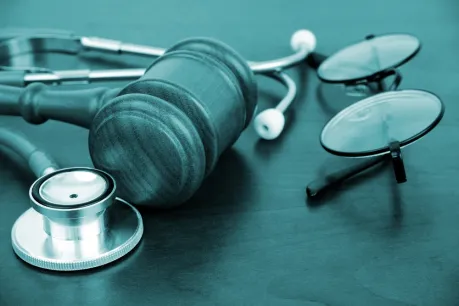Taking Your Medical Malpractice Lawsuit to Court: Everything You Need to Know

Injured?
When you place your health in the hands of a doctor, nurse, or hospital, you expect to receive competent, professional care, but when healthcare professionals make preventable mistakes, the consequences can be catastrophic—sometimes even fatal.
If you or a loved one suffered harm due to a medical provider’s negligence, you may be wondering whether it’s time to take legal action.
At Morgan & Morgan, we’ve seen firsthand how medical malpractice can change lives and hurt innocent patients. Below, we share everything you need to know about taking a medical malpractice lawsuit to court. If you need more information about your specific claim, contact us anytime for a free case evaluation.
What Is Considered Medical Malpractice?
Medical malpractice occurs when a healthcare professional deviates from the accepted standards of medical care, resulting in harm to the patient. It's not simply about a bad outcome. Rather, it's about negligence or incompetence that leads to injury or worsening of a condition.
To be considered malpractice, a case must typically meet the following criteria:
- Duty of care: A doctor-patient relationship existed, and the provider had a responsibility to offer competent care.
- Breach of duty: The provider failed to meet the standard of care expected in their field.
- Causation: The provider’s failure directly caused the injury or worsened the patient’s condition.
- Damages: The patient suffered physical, emotional, or financial harm as a result.
Common types of medical malpractice include:
- Misdiagnosis or delayed diagnosis
- Surgical errors
- Medication mistakes
- Birth injuries
- Anesthesia errors
- Failure to inform the patient of risks (lack of informed consent)
If you’ve experienced any of these, a medical malpractice attorney can help determine whether you have a case worth pursuing in court.
When Should I Take My Medical Misdiagnosis to Court?
Not every medical error leads to a lawsuit, but some do. A misdiagnosis, especially if it results in delayed treatment or the wrong treatment, can lead to serious complications.
You may want to consider legal action if:
- You were diagnosed with the wrong condition and suffered harm due to improper treatment.
- A delayed diagnosis allowed your condition to worsen significantly.
- A serious illness (like cancer) went undetected despite your symptoms.
- Your provider ignored test results or failed to order necessary diagnostic tests.
If the misdiagnosis led to severe consequences, like loss of a limb, permanent disability, or wrongful death, you may be entitled to compensation. In cases like these, the courtroom may be the best avenue to hold negligent parties accountable and recover damages for your losses.
What Kind of Court Oversees Medical Malpractice Lawsuits?
Medical malpractice lawsuits are typically handled in civil court, not criminal court. These cases fall under tort law, which governs situations where one party's negligence causes harm to another.
Depending on your state and the amount of damages you're seeking, your case may be heard in:
- State trial courts: Where most malpractice claims are filed, especially if the care occurred at a local hospital or private practice.
- Federal court: If the defendant is a federal institution (like a VA hospital) or if the parties are from different states and the claim exceeds a certain dollar threshold.
- Specialized medical courts: A few states use medical review panels or dedicated healthcare courts to screen cases before they reach the traditional court system.
The goal of these courts is to determine whether the healthcare provider breached their duty and whether that breach directly caused the injury.
What Kind of Legal Action Is a Malpractice Suit?
A medical malpractice lawsuit is a civil tort claim. Specifically, it's an unintentional tort, which means it involves negligent, not intentional, conduct.
The legal process typically includes:
- Filing a complaint: Your attorney files a formal legal document in court.
- Discovery: Both sides gather evidence, interview witnesses, and consult expert medical testimony.
- Settlement negotiations: Many malpractice cases settle out of court, often before trial.
- Trial: If no settlement is reached, the case proceeds to trial, where a judge or jury decides the outcome.
Unlike criminal cases, the goal of a malpractice suit is not to punish the provider with jail time, but to compensate the victim for their losses.
What Is the Statute of Limitations in the Healthcare Sector?
Each state sets its own statute of limitations for medical malpractice claims. This is the legal time limit you have to file a lawsuit. Once that period passes, you may lose the right to sue.
Common timeframes for most states are 1 to 3 years from the date of the injury or from when you reasonably discovered the harm. Some states extend the time limit for cases involving minors or incapacitated individuals. If the provider intentionally hid their negligence, courts may grant more time.
Because these rules are so specific, it's very important to speak with a qualified attorney as soon as you suspect malpractice.
What Are Some Examples of Famous Medical Malpractice Cases?
Medical malpractice has made headlines over the years. Some of the most well-known cases have helped shape the legal and healthcare systems we know today.
The cases mentioned below are provided for illustrative purposes only. They are not intended to predict or guarantee similar outcomes in any future legal matters. Each case is unique and must be evaluated on its own merits.
Libby Zion Case (1984)
After an 18-year-old college student died from a medication error in a New York hospital, public outcry led to changes in medical residency work hours. The case highlighted overworked interns and a lack of supervision, resulting in reforms that still affect training programs today.
Michael Jackson's Death (2009)
While technically a criminal case, Jackson’s physician, Dr. Conrad Murray, was convicted of involuntary manslaughter for administering a lethal dose of propofol. The case shed light on the risks of improper medication use and the responsibility physicians carry.
Willie King Case (1995)
In Florida, a surgeon amputated the wrong leg of a diabetic patient. The case ended in a $900,000 settlement and sparked national conversations about surgical safety and checklist protocols.
What Are the Most Common Examples of Wrong Medication Cases?
One of the problems with litigating a case that involves a prescription drug error is some patients do not develop negative reactions to a wrong drug until days or even weeks after ingesting the incorrect drug.
Let’s review the most common types of wrong medication cases.
Mistaken Drug Names and Symbols
Even the most experienced physicians make mistakes with drug names and symbols. From referring to outdated terminology to mistakenly deciphering symbols, a doctor can mistakenly identify a medication, which can put a patient in serious trouble. This type of wrong medication case often causes an adverse reaction in patients who cannot tolerate certain ingredients.
The Institute for Safe Medication Practices (ISMP) has developed a list of symbols, abbreviations, and dose designations that should help healthcare providers avoid the common type of wrong medication case.
Administering a Drug the Wrong Way
Healthcare providers administer prescription medications in several different ways, including orally, as well as via eye/ear drops, injection, or topical application. Prescription drugs require a specific method of administration, and if a healthcare provider chooses the wrong drug route, a patient can suffer devastating side effects. Incorrectly reading abbreviations is the primary cause why healthcare providers administer prescription drugs the wrong way.
Dosage Errors
Dosage errors not only can cause serious health issues, but giving a patient the incorrect dose of a prescription drug can also be fatal. Although pharmacists make this type of mistake, healthcare providers also prescribe the wrong dose of a prescription drug. Dosage errors can be caused by inattention, reading the wrong patient chart, and writing down the incorrect terms for dosage. For example, a microgram is much different than a milligram. Recommending the wrong size spoon for oral administration is another common cause of drug dosage errors.
Prescribing the Wrong Prescription Medications
The names of prescription drugs can confuse even the most experienced healthcare providers. Look at the subtle difference in the spelling between clomiphene and clomipramine. Because physicians are frequently rushed when working with patients, it is easy for them to mistake the name of a drug. The result can be that a patient suffers a catastrophic injury because of the confusion caused by two drug names.
According to a research study released by the Pennsylvania Patient Safety Authority, nearly 25 percent of all wrong medication cases involve confusion surrounding the names of prescription medications.
Patient Information Swap
When two or more patients share a room, the information for each patient might end up in the wrong hands. When the time comes for a nurse to administer a prescription drug, the nurse might refer to the wrong patient’s chart and administer a drug that can cause serious harm. Doctors can make the same mistake by referring to the wrong patient’s chart when writing out a prescription.
Unauthorized Drug Prescription
When the Food and Drug Administration (FDA) approves a medication for use, the federal agency limits the use of the drug to a limited number of medical conditions. Every drug that receives approval for use by the FDA is considered safe and effective for its intended use. Some physicians prescribe off-label drugs without discussing the possible side effects with patients. Prescribing a medication the FDA has not approved can cause long-term harm.
What Is a Typical Medical Malpractice Injury Settlement Amount?
Medical malpractice settlements vary widely depending on the injury’s severity, the strength of the evidence, and the laws in your state.
According to the National Practitioner Data Bank, the average payout for medical malpractice in the U.S. in recent years has been around $350,000, but verdicts in catastrophic cases can go much higher.
Keep in mind, non-economic damages (like pain and suffering) may be capped in some states. Fortunately, economic damages (like lost wages and medical bills) are generally not capped. Punitive damages are rare but also possible if there’s evidence of gross negligence or misconduct.
To know a more accurate estimation of your own claim’s value, you need to speak to an experienced attorney at Morgan & Morgan.
What Is an Example of an Unintentional Tort in the Medical Field?
An unintentional tort occurs when a person causes harm through carelessness rather than intentional harm. In medicine, most malpractice cases fall into this category.
For example, imagine a surgeon accidentally leaves a sponge inside a patient’s body during an operation. The patient later experiences severe pain and infection, requiring additional surgeries.
The surgeon didn’t mean to hurt the patient, but their negligence and the failure to account for all surgical tools caused injury. This is classic medical malpractice under an unintentional tort theory.
What Are Some Signs That You Need a Medical Malpractice Lawyer?
If you’re unsure whether you need a lawyer, here are some warning signs that it may be time to get legal help:
Unexpected or unexplained injury
You developed complications after a routine procedure, or something just doesn’t feel right, and your provider can’t explain why.
Your condition worsened after treatment
If your health declined due to a misdiagnosis, delayed treatment, or incorrect care, you may have grounds for a claim.
Your doctor won’t answer questions
Lack of communication, refusal to share records, or evasion can be red flags.
You needed additional treatment or surgery
Needing corrective procedures due to an earlier mistake is often a sign of negligence.
You’ve incurred significant expenses
If you’ve missed work, faced high medical bills, or suffered long-term effects, an attorney can help you seek compensation.
A loved one died unexpectedly
If a sudden or unexplained death occurred during medical treatment, especially if there were previous concerns, legal consultation is critical.
How Morgan & Morgan Can Help
Medical malpractice cases are some of the most complex personal injury claims out there. They require expert testimony, deep knowledge of healthcare standards, and the resources to take on powerful hospital systems and insurance companies.
At Morgan & Morgan, we have a dedicated team of medical malpractice attorneys who have recovered billions of dollars for clients across the country. We work on a contingency fee basis, meaning you never pay out of pocket. The Fee Is Free®, and we only get paid if we win your case.
We believe in fighting For the People, not the powerful. If you or a loved one was harmed due to medical negligence, don’t wait. Our attorneys are here to listen to your story, review your medical records, and help you get the justice you deserve.

We've got your back
Injured?
Not sure what to do next?
We'll guide you through everything you need to know.
